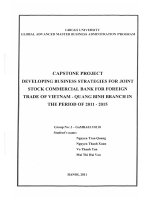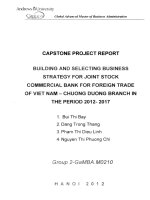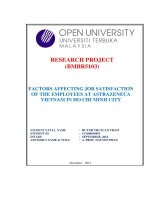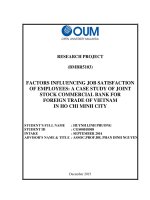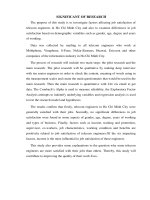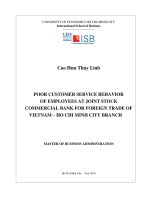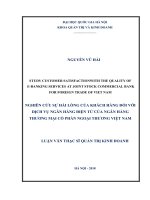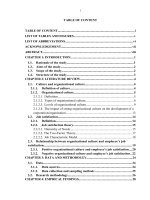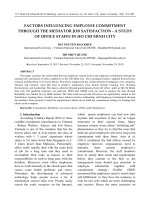Factors influencing job satisfaction of employees a case study of joint stock commercial bank for foreign trade of viet nam in ho chi minh city
Bạn đang xem bản rút gọn của tài liệu. Xem và tải ngay bản đầy đủ của tài liệu tại đây (1.57 MB, 95 trang )
RESEARCH PROJECT
(BMBR5103)
FACTORS INFLUENCING JOB SATISFACTION
OF EMPLOYEES: A CASE STUDY OF JOINT
STOCK COMMERCIAL BANK FOR
FOREIGN TRADE OF VIETNAM
IN HO CHI MINH CITY
STUDENT’S FULL NAME
STUDENT ID
INTAKE
ADVISOR’S NAME & TITLE
: HUYNH LINH PHUONG
: CGS00018508
: SEPTEMBER 2014
: ASSOC.PROF.DR. PHAN DINH NGUYEN
December 2015
Advisor’s assessment
.....................................................................................................................................................................
.....................................................................................................................................................................
.....................................................................................................................................................................
.....................................................................................................................................................................
.....................................................................................................................................................................
.....................................................................................................................................................................
.....................................................................................................................................................................
.....................................................................................................................................................................
.....................................................................................................................................................................
.....................................................................................................................................................................
.....................................................................................................................................................................
.....................................................................................................................................................................
.....................................................................................................................................................................
.....................................................................................................................................................................
.....................................................................................................................................................................
.....................................................................................................................................................................
.....................................................................................................................................................................
.....................................................................................................................................................................
Advisor’s signature
Huynh Linh Phuong
Page i
ACKNOWLEDGEMENTS
First of all, I would like to send my special thanks to Open University Malaysia
and Hutech University had opened a very excellent MBA course for us; and given us
an opportunity to study, to expand our knowledge. And especially, I would like to
express my special gratitude to our Business Research Methods course lecturer, Dr.
Phan Dinh Nguyen who has shown our class every step of how to do a research and run
SPSS software. Your devoted, enthusiastic, attentive instruction and support that you
have given truly help me lot in progression and smoothness of the Case Study. Without
your teaching & guidance, this Case Study would not be completed.
Moreover, I want to thank the board of managers and all employees working the
branches and transaction offices of Joint Stock Commercial Bank for Foreign Trade of
Vietnam (VCB) in Ho Chi Minh City for their precious comments and helping me to
collect data for this research study.
And finally, I wish to give my sincerest and deepest gratitude to my family and
all of my sweet friends who always stay next to me, encourage, help, create favorable
conditions for me to study and overcome obstacles in life.
Huynh Linh Phuong
Page ii
ABSTRACT
This study examined the impact of job stress, distributive & procedural justice,
working conditions and perception of organization politics on job satisfaction of
employees working in Joint Stock Commercial Bank for Foreign Trade of Vietnam
(VCB) in Ho Chi Minh City. Data was collected through the use of standardized
questionnaires. Questionnaires were given personally to 200 managerial and nonmanagerial employees in all over 8 branches and transaction offices of VCB; there
were 290 completely responses were used for the statistical analysis. The collected
data were computed and analyzed through Cronbach’s alpha analysis, factor analysis,
correlation analysis, and multiple regression analysis. The results of the study
supported the hypotheses that job stress, distributive & procedural justice, working
conditions and perception of organization politics (including general political behavior
and get ahead) has significant relationship with employee’s job satisfaction.
Conclusion: The findings in this study would help managers of VCB to formulate
strategies that involved work factors to improve the management of human resource
development. These strategies would help in influencing positive behaviors among
employees, and hence achieve effectiveness and high productivity in the organization.
The results also suggest reducing work stress, improvement of its working conditions
such as clear key performance indicators, more empowerment for decision making,
ownership of stock and to obtain high commitment of staff to work for the company.
Therefore, it was worth the effort for the organization to train and educate their
managers on the impact of perceptions of organizational justice on the motivation and
commitment of their employees. This study has valuable implications for the Human
Resources Department of VCB to improve its policies in order to retain talents.
Keywords: Job satisfaction, job stress, distributive & procedural justice, working
conditions, and perception of organizational politics.
Huynh Linh Phuong
Page iii
LIST OF ABBREVIATIONS
No.
Abbreviation
Definition
Joint Stock Commercial Bank for Foreign Trade of
1
VCB
2
JS
Job Satisfaction
3
JSS
Job Stress Scale
4
DPJ
Distributive & Procedural Justice
5
WC
Working Conditions
6
POPS
Perception of Organizational Politics Scale
7
GPB
General Political Behavior
8
GA
Get Ahead
9
SPSS
Huynh Linh Phuong
Vietnam
Software Package for Social Sciences
Page iv
LIST OF TABLES
No.
Table
Page
1
Table 1: Measurements and sources
30
2
Table 2: Cronbach‘s Alpha analysis results
35
3
Table 3: KMO and Bartlett‘s Test result of independent
variables
36
4
Table 4: Factor analysis results
38
5
Table 5: KMO and Bartlett‘s Test result of dependent variable
39
6
Table 6: Results of Correlation Analysis
41
7
Table 7: Results of Regression Analysis
42
8
Table 8: Results of Hypothesis Testing
48
Huynh Linh Phuong
Page v
LIST OF FIGURES
No.
Figure
1
Figure 1: Job Satisfaction model in study of Smith, Kendall,
& Hulin (1969)
2
Figure 2: Model of items measuring job satisfaction of
Weiss et al (1967)
3
4
Figure 3: Research model of Job Satisfaction
Figure 5: Adjusted research model
Huynh Linh Phuong
Page
23
24
25
40
Page vi
TABLE OF CONTENTS
ACKNOWLEDGEMENTS .......................................................................................... ii
ABSTRACT .................................................................................................................. iii
LIST OF ABBREVIATIONS...................................................................................... iv
LIST OF TABLES ........................................................................................................ v
LIST OF FIGURES ..................................................................................................... vi
TABLE OF CONTENTS ............................................................................................ vii
CHAPTER 1: INTRODUCTION ................................................................................ 1
1.1
Problem Statement ............................................................................................. 1
1.2
Background of VCB .......................................................................................... 2
1.3
Research Objectives .......................................................................................... 4
1.3.1 General objectives........................................................................................ 4
1.3.2 Specific objectives ....................................................................................... 5
1.4
Research questions ............................................................................................ 5
1.5
Scope and methodology of the study................................................................. 5
1.6
Importance of the study ..................................................................................... 5
1.7
Significance of the study ................................................................................... 6
1.7.1 Individual Perspective.................................................................................. 6
1.7.2 Organizational perspective .......................................................................... 6
1.8
Research structure.............................................................................................. 7
CHAPTER 2: LITERATEUR REVIEW .................................................................... 9
2.1
Job Satisfaction .................................................................................................. 9
2.2
Job Stress Scale and its relationship with Job Satisfaction ............................. 10
2.3
Distributive & Procedural Justice and its relationship with Job Satisfaction . 12
2.4
Working Conditions and its relationship with Job Satisfaction ...................... 15
Huynh Linh Phuong
Page vii
2.5.....Perception of Organizational Politics and its relationship with Job Satisfaction
17
2.6
Review of Relevant Theoretical Models ......................................................... 21
2.7
Research model................................................................................................ 24
CHAPTER 3: RESEARCH METHODLOGY......................................................... 26
3.1
Research design ............................................................................................... 26
3.2
Data collection methods .................................................................................. 26
3.3
Sample design .................................................................................................. 27
3.3.1 Target population ....................................................................................... 27
3.3.2 Sample frame and sample location ............................................................ 28
3.3.3 Sampling technique.................................................................................... 28
3.3.4 Sample size ................................................................................................ 28
3.4
Hypotheses, variable description, regression model ....................................... 29
3.5
Data analysis .................................................................................................... 32
CHAPTER 4: RESEARCH RESULTS .................................................................... 34
4.1
Reliability analysis .......................................................................................... 34
4.2
Factor analysis ................................................................................................. 35
4.2.1 Factor analysis for independent variables.................................................. 35
4.2.2 Factor analysis for dependent variable ...................................................... 39
4.2.3 Adjusted research model ............................................................................ 39
4.3
Correlation Analysis ........................................................................................ 41
4.4
Regression analysis.......................................................................................... 42
CHAPTER 5: CONCLUSION ................................................................................... 46
5.1
Conclusion and Recommendations ................................................................. 46
5.2
Limitation of the study .................................................................................... 52
REFERENCES ............................................................................................................ 54
APPENDIX A: Pilot Test – Reliability ...................................................................... 62
Huynh Linh Phuong
Page viii
Job Stress Scale ......................................................................................................... 62
Distributive and Procedural Justice .......................................................................... 64
Working Conditions .................................................................................................. 65
Perception of Organizational Politics Scale ............................................................. 67
Job Satisfaction ......................................................................................................... 69
APPENDIX B: Factor Analysis ................................................................................. 71
Dependent variable ................................................................................................... 71
Independent variables ............................................................................................... 72
APPENDIX C: Regression Analysis .......................................................................... 78
QUESTIONNAIRE ..................................................................................................... 80
Huynh Linh Phuong
Page ix
CHAPTER 1: INTRODUCTION
1.1 Problem Statement
In the last decade, employee welfare and satisfaction have become a major
concern for management in organizations. This concern has been noticed from the
realization that trained, experienced, satisfied, and committed employees can be pivotal
for long-term organizational success. Retention of dedicated employees can prove to be
a key to success because frequent employee turnover can lead to a number of problems,
such as insufficient workforce, the costs of recruiting and training new employees, and
organizational inefficiency and lack of productivity. All these increase the burden on
management. Hence, keeping employees satisfied, motivated, committed, and long
serving in their jobs has been identified as an important task for managers.
Today, the researchers acknowledge that personnel attitudes, qualifications, and
skills of employees are the most important resources for all organizations. Retaining
talent becomes a pressing issue for all businesses. In Vietnam, the problem ―how to
attract and retain employees‖ is also an important problem for managers of enterprises.
Especially after Vietnam joined the WTO, domestic enterprises have the need of
expanding production and business, apart from the needed manpower with high
quality; they must also know how to retain qualified employees. Stabilizing human
resources helps organizations save recruitment costs, training costs, contributing to
building the organizational culture and creating trust for employees. An important
finding for organizations to note is that job satisfaction has a rather tenuous correlation
to productivity on the job. This is a vital piece of information to researchers and
businesses. Staffs who are satisfied with their work will have greater contribution to
the organization, which is the key to improve work efficiency and productivity,
increase loyalty to the organization. Satisfied employees can be an asset for the
organization. Once employees feel dissatisfied with the job, they switch over to the
next job. It is the responsibility of the employers to know how to attract, satisfy and
Huynh Linh Phuong
Page 1
retain their best employees. All managers, business owners are recognizing that they
must always pay very high prices for the leaving of key partners. One of the problems
often seen as the departure of key partners would bring about the leaving of the
customers. Moreover, if there is constant departure of key employees, there will trigger
waves of the leaving the entire remaining staffs.
Studies showed that the job satisfaction of employees will enhance work
efficiency and improve work productivity (Saari and Judge, 2004), or loyalty to the
organization (Luddy, 2005; Tietjen and Myer, 1998). Therefore, researching on factors
affecting job satisfaction of the employees offers enormous practical significance,
helps them to adjust their human management policies in an appropriate way and carry
out the strategic objectives of the organization. By using quantitative research methods,
this study aims to find out the factors influencing job satisfaction of employees and
offer some ideas to help the organization build the human resource policies which are
more attractive to employees.
1.2 Background of VCB
Joint Stock Commercial Bank for Foreign Trade of Vietnam, formerly known as
Bank for Foreign trade of Vietnam, was established on 01/04/1963 from the Foreign
Exchange Bureau (of the State Bank of Vietnam). Being the first state commercial
bank chosen for pilot privatization by the Government, VCB officially came in to
operation on 02/06/2008, after successfully implementing the equitization plan through
IPO. VCB (stock code: VCB) officially listed on the Ho Chi Minh Stock Exchange
(HOSE) on 30/06/2009.
During more than 50 years of development, VCB has contributed significantly
to the stability and growth of national economy, upholding the role of a major foreign
trade bank in facilitating efficient domestic economic growth as well as influencing
considerably on regional and global financial community.
Huynh Linh Phuong
Page 2
Originated as a specialized bank for foreign trade, VCB nowadays has become a
bank providing customers with a wide range of leading financial services in
international trade; traditional services such as capital trading, capital mobilization,
credit, project financing…etc., and modern banking segment such as trading and
derivatives, card services, e-banking and so on.
VCB has many advantages of applying advanced technology into the automatic
banking system, products development, and e-banking services, based on its high
technology foundation. Products such as Internet Banking, VCB Money, SMS
Banking, Phone Banking have always attracted a great deal of customers by its
convenience, promptness, safety, efficiency, creating the habit of non-cash payments
amongst the mass.
After more than a half-century operating in the market, VCB currently has
almost 14,000 employees, more than 400 branches/ transaction offices/ representative
office/ affiliates both in Vietnam and abroad, including Head Office in Hanoi, 1
Operation Center, 1 Training Center, 89 branches, over 350 transaction offices all over
the country, 2 subsidiaries in Vietnam, 2 subsidiaries and 1 representative office in
other countries, 6 joint ventures. In addition, VCB has also developed an auto bank
system with over 2100 ATMs and more than 49,500 Points of Sale nationwide. Bank‘s
operations are supported by a network of more than 1,800 correspondent banks in 155
countries and territories.
VCB ‘s team of professional employees with excellent ability in banking and
finance have a good sense for modern and integrated business environment…Thanks to
their contribution, VCB remains the primary choice for large corporations, domestic
and foreign enterprises as well as millions individual customers.
For more than a decade, VCB has continuously rated as "Best Bank in Vietnam"
by prestigious institutions around the world on many important operation fields.
Huynh Linh Phuong
Page 3
With wisdom and enthusiasm, every generation of VCB ‘s employees has been
and will always be endeavoring to establish a sustained development with ambition to
became a bank has a wide range, great admin ability, working scope that could
influenced the region and overseas in the near future.
At present, there are 23 branches and transaction offices of VCB in Ho Chi
Minh City. To get the development as it is today, VCB has always attached special
importance to the human resources. The bank has made great efforts in the
management of their human resources, but the effect is not as expected; the number of
officials and employees resigning, transferring to other job is increasing; which has
significant influence on operations of the organization. In addition, international
economic integration becomes a trend of the times and going strong in many areas and
accordingly, in parallel with the world market reaching out, Vietnam must open the
domestic market, including the finance banking sector. The competition of
organizations in the field of finance and banking is increasingly becoming tough,
especially human resources factor as quality of staffs is one of the intrinsic factors
affecting the competitive competence of the bank. Facing to this situation, to keep a
long term employees the bank should have policies encouraging their staffs to be
assured, close-knit with the organization. Understanding factors underpinning job
satisfaction offers a significant meaning to the bank, helping them to adjust their
human management policies sensibly. Therefore, the study of job satisfaction of
employees at VCB in Ho Chi Minh City is necessary. In this background the present
study entitled ―Factors Influencing Job Satisfaction of Employees: A Case Study of
Joint Stock Commercial Bank for Foreign Trade of Vietnam in Ho Chi Minh City‖ was
conducted. The main focus of this study was to assess the job satisfaction of bank
employees in the context of organizational factors.
1.3 Research Objectives
1.3.1
General objectives
Huynh Linh Phuong
Page 4
Identify the factors influencing job satisfaction of employees in Joint Stock
Commercial Bank for Foreign Trade of Vietnam in Ho Chi Minh City.
1.3.2
Specific objectives
The current study seeks to achieve the following objectives:
1) To identify the factors affecting job satisfaction of the employees.
2) To measure the influence degree of the factors on job satisfaction of the
employees.
3) To provide the solutions to increase job satisfaction of the employees.
1.4 Research questions
In this study, there are some questions created:
1) What are the factors influencing job satisfaction of the employees?
2) What are the influence degrees of the factors on job satisfaction of the
employees?
3) How can the organization increase job satisfaction of the employees?
1.5 Scope and methodology of the study
The thesis researches the issue via 168 employees working in 6 departments
(such as corporate banking, trade finance, personal banking, information technology,
audit and legal & compliance) of 8 branches and transaction offices of VCB in Ho Chi
Minh City in 2015. In this study, qualitative research method is utilized to obtain
information with reference for the research. The researcher uses the comparative
method, analysis in order to provide a solid theoretical basis. Besides, the thesis also
applies the research results of the scientific work related to enriching and deepening
the theoretical basis and practical topics. Quantitative research method is also used in
the study. Quantitative research generates statistics through the use of survey research,
using methods such as questionnaires or structured interviews and SPSS software (the
Software Package for Social Sciences) for data analysis.
1.6 Importance of the study
Huynh Linh Phuong
Page 5
The importance of this study stems from being one of the few studies that
addressed the sector of the study of some important variables with dimensions such as
job stress, distributive and procedural justice, working conditions and perception of
organization politics. In addition, the current study has dealt with effect of variables
collectively and individually on the job satisfaction of the employees to the
organization they work in.
1.7 Significance of the study
This study is beneficial to two parties, which were employees and the
organization particularly Joint Stock Commercial Bank for Foreign Trade of Vietnam.
From the study, the researcher has investigated the factors which will affect job
satisfaction of employees to their current organization.
1.7.1
Individual Perspective
The poor level of the employee turnover management and human resource
management bring a serious impact to the organization. It will affect the employee
satisfaction and influence work efficiency and productivity or the loyalty of the
employees to the organization. Through the study, the ideas and needs of the
employees can transmit to the top management of the organization. As the results, they
need the improvement of management skills and policies, controlling the management
process and performance to let employees feel more satisfied, secure, ease and
motivated to their job tasks.
1.7.2
Organizational perspective
The study will help the organization to identify the impact of employee
satisfaction. If the organization is unable to attract and retain the employees, it will
increase the turnover rate of them and the cost of retraining or replacement program to
new employees. The cooperation and teamwork is needed among the employees to
improve the performance of the organization and profit maximization. Through the
study, the organization can understand the factors influencing job satisfaction of the
Huynh Linh Phuong
Page 6
employees. The top management of the organization can implement the relevant
strategies in term and build the human resource policies which are more attractive to
employees to increase job satisfaction of the employees. So, the organization can be
able to retain the employees and improves its operation performance.
1.8 Research structure
The thesis consists of 5 chapters:
Chapter 1: Introduction
This chapter gives an overall review of entire research; introduces the reason for
choosing the topic. The problem statement, research objectives and questions, scope
and methodology of the research, the importance of the study; and significance of the
research study are also explained in this chapter.
Chapter 2: Literature review
This chapter shows the definition of Job Satisfaction, Job Stress, Distributive &
Procedural Justice, Working Conditions, Perception of Organization Politics and their
relationship with Job Satisfaction. The chapter also mentions to the theories of
satisfaction from some previous researchers, and give out the research model for this
topic.
Chapter 3: Research Methodology
This chapter focus on discussion of research of research method where it
describe the procedure of how the research carry out in terms of the research design
and setting, data collection method, sampling design, research instrument, constructs
measurement scales, data processing and the data analysis. This chapter defines the
hypotheses of factors that impact to the job satisfaction of employees and the
regression model.
Chapter 4: Research Results
Huynh Linh Phuong
Page 7
This chapter includes the overall result and analysis of questionnaire will be
present in chart and table with using the Statistical Package of Social Science (SPSS).
The interpretation of result will explained in depth.
Chapter 5: Conclusion
This chapter will show the conclusion of the factors that impact to the
satisfaction of employees. Then, give out some solution for improving better. Lastly
the limitation of study and recommendation for future research will be presented
Huynh Linh Phuong
Page 8
CHAPTER 2: LITERATEUR REVIEW
2.1 Job Satisfaction
It is difficult to define exactly job satisfaction of the employees in an
organization. General speaking, job satisfaction is recognized as an overall sense of the
work or the extent to which the people like or dislike their jobs (Spector, 1997). It
reflects the feeling of employees whereby they express contentment and a positive
attitude towards the work and organization. The other popular definition of job
satisfaction is given by Locke (1983), who defined job satisfaction as a pleasure of
positive emotional state resulting from the appraisal of one's job experience. This
definition includes both cognitive (an appraisal of one's job) and affective (emotional
state) elements, denoting the degree to which individuals feel positive or negative
about their jobs. Rice et al (1989) suggested that satisfaction comes from a process of
psychological comparison involving assessment of current work itself with the
available expected standards. Togia et al (2004) believed that employee satisfaction is
the degree to which the employee‘s needs are satisfied at work.
It can be seen that the problem of employee satisfaction was first studied by
scholars such as Maslow (1943), Adam (1963) and Mc. Clelland (1958). With a view
to "the needs are met", the authors argued that satisfaction is generally that the received
value is equal to or greater than the expected value. On the basis of that theory, some
researchers later inherited and developed needs of satisfaction, they defined that
general satisfaction is considered as the actual value which the employees get
compared with the expected value on aspects of work such as wage and benefits, work
characteristic, work relationships, work conditions… Another view is that the
satisfaction level of employees is the level of enjoying the work, or trying to maintain
the employee's work reflected the perception (positive or negative or a combination of
them) on different aspects of work affecting themselves (Herzberg (1968) and Alderfer
(1969)). It is commonly accepted that job satisfaction is a contributing factor to the
Huynh Linh Phuong
Page 9
physical and mental well-being of the employees; therefore, it has significant influence
on job-related behaviors such as productivity, absenteeism, turnover rates and
employee relations (Becker, 2004). It also plays an important role in improving the
financial standing of organizations (Aronson, Laurenceau, Sieveking, & Bellet, 2005).
Thus, understanding job satisfaction of employees is an important organizational goal
(Aronson et al., 2005).
So there are many different definitions of job satisfaction. Obviously, the state
of satisfaction or dissatisfaction of the employees on the job through different
evaluation criteria is different. It can be considered that job satisfaction is the state
when the employees feel excited and comfortable and express positive response to
aspects of their work. Satisfied employees can be an asset for the organization.
Satisfaction is affected by personal, organizational, and non-organizational factors.
Within organizations, factors such as strategies of human resource management, work
place benefits, workplace climate, well-being of the employees, interpersonal relations,
and nature of supervision contribute to satisfaction.
2.2 Job Stress Scale and its relationship with Job Satisfaction
Brief, Schuler, and Sell (1981) defined that stress is a state of tension
experienced by individuals facing extraordinary demands, constraints, or opportunities.
Generally speaking, job stress has a connection with someone‘s response to anxious
tension consequences from job environment. Stress results from the complicated
interactions among a large system of interrelated variables (Hart, 1999). Colligan,
Thomas, and Higgins (2006) found that factors contributing to workplace stress include
excessive workload, isolation, extensive hours worked, toxic work environment, lack
of autonomy, difficult relationships among coworkers and superiors, harassment, and
lack of opportunities or motivation to advancement in one‘s skill level. The employee‘s
satisfaction is not performing as well as they do because of the stress in their mind.
According to Naghieh, Montgomery, Bonell, Thompson, & Aber, 2015), job stress can
Huynh Linh Phuong
Page 10
also be caused by a mismatch between perceived reward, a sense of low control in
demanding job, low social support at work and job insecurity. In addition, Colligan and
Higgins (2010) also believed that stress is a stimulus for the human resource to work
harder and motivates the employee in their productivity due to improved employee
performance in organization. However, on the contrary, there is also a harmful result
for the organization if the employees do not perform according to the expectation and
requirement of the organization.
There are many researchers having defined job stress and the relationship with
employee satisfaction in different words. For example, Jamal & Baba (1992) believed
that job stress was negatively correlated with organizational commitment and job
satisfaction and positively correlated with role ambiguity and overload. The frequency
of stressful events was positively correlated with psychological distress, quantitative
workload, qualitative workload, self-monitoring, and somatic complaints. The
frequency of job stress correlated negatively with job satisfaction, job performance,
and job control (Fox & Dwyer, 1995; Fox et al., 1993).
This study adopts the Job Stress Scale developed by Parker and Decotiis (1983).
The scale uses 10 items to measure job stress along two dimensions. One dimension is
time stress (feelings of being under constant pressure) and the second dimension is
anxiety (job-related feelings of anxiety).
Job stress is increasingly becoming an epidemic in the work environment. Stress
not only affects the health of employees, but also affects their work performance.
Stressful employees are very unlikely to engage in positive behavior that is not
required by their formal functions and duties. When there is high level stress and their
mental condition are not according to their level of activity, results lower level of
productivity for the organization. Thus, the hypothesis which is used to analyze the
relationship between job stress and job satisfaction is:
Hypothesis 1: Job Stress is negatively related to Job Satisfaction.
Huynh Linh Phuong
Page 11
2.3 Distributive & Procedural Justice and its relationship with Job Satisfaction
Organizational justice refers to the perceived fairness of social and economic
exchanges among employees and their work organizations (Beugre, 1998). One aspect
of organizational justice is that employees determine their perception of fairness in the
workplace by comparing the equity of the ratio of their inputs to their outcomes in
comparison to those of their co-workers. This results in a judgment about distributive
justice. According to Dailey & Kirk (1992), it is a summary judgment about the
fairness of managerial decisions concerning the distribution of outcomes such as pay
and promotions. Another view of organizational fairness is procedural justice that
concentrates on how such decisions are made. The process for making organizational
decisions may be just as important to the employees as their perception of outcome
fairness. Procedural justice is concerned with the perception of fairness in the use of
processes, procedures and methods in making outcome decisions (Thibaut & Walker,
1975). These two types of justice have different effects on the perception of
organizational fairness. For example, Folger and Konovsky (1989) found that
distributive justice has a much greater impact on pay satisfaction than procedural
justice, whereas procedural justice tends to affect an employee‘s organizational
commitment and trust in his or her supervisor or boss (Dailey & Kirk, 1992).
Schermerhorn, Hunt, and Osborn (2002, p.13) defines Distributive Justice as ―the
degree to which all people are treated the same under a policy, regardless of race,
ethnicity, gender, age, or any other demographic characteristic‖ and Procedural Justice
as ―the degree to which the rules and procedures specified by policies are properly
followed in all cases under which they are applied‖.
There are many studies about distributive and procedural justice and the
relationship with job satisfaction. For example, distributive and procedural justice are
both correlated positively with employee pay level, intention to stay in a job, job
satisfaction, supervisor‘s evaluation of the employee, and organizational commitment
Huynh Linh Phuong
Page 12
(Sweeney & McFarlin, 1997). Reviews of organizational justice and satisfaction
studies in general (Colquitt et. al., 2001) and a review of justice studies in the sales
force only (Chang and Dubinsky, 2005) concluded that all justice types are positively
related to job satisfaction. Other study (Parker et al., 1997) has also observed that both
procedural and distributive justice correlated positively with career development
opportunities, satisfaction with work, and loyalty to the organization.
Distributive Justice
Before 1975, the study of justice was primarily concerned with distributive
justice. Much of this research was derived from initial work conducted by Adams
(1965), who used a social exchange theory framework to evaluate fairness. According
to Adams, what people were concerned about was not the absolute level of outcomes
per se but whether those outcomes were fair. Adams suggested that one way to
determine whether an outcome was fair was to calculate the ratio of one‘s contributions
or ―inputs‖ (e.g., education, intelligence, and experience) to one‘s outcome and then
compare that ratio with that of a comparison other. Although the comparison of the two
input-outcome ratios gives Adams‘s equity theory an ―objective‖ component, he was
clear that this process was completely subjective.
Whereas Adams‘s theory advocated the use of equity rule to determine fairness,
several other allocation rules have also been identified, such as equality and need (e.g.,
Leventhal, 1976). Studies have shown that different contexts (e.g., work vs. family),
different organizational goals (e.g., group harmony vs. productivity), and different
personal motives (e.g., self-interest motives vs. altruistic motives) can activate the use
or primacy of certain allocation rules (Deutsch, 1975). Nevertheless, all of the
allocation standards have as their goal the achievement of distributive justice; they
merely attempt to create it through the use of different rules.
Procedural Justice
Huynh Linh Phuong
Page 13
With the publication of their book summarizing disputant reactions to legal
procedures, Thibaut and Walker (1975) introduced the study of process to the literature
on justice. Thibaut and Walker (1975)
viewed
third-party
dispute
resolution
procedures such as mediation and arbitration as having both a process stage and a
decision stage. They referred to the amount of influence disputants had in each stage as
evidence of process control and decision control, respectively. Their research
suggested that disputants were willing to give up control in the decision stage as long
as they retained control in the process stage. Stated differently, disputants viewed the
procedure as fair if they perceived that they had process control (i.e., control over the
presentation of their arguments and sufficient time to present their case). This process
control effect is often referred to as the ―fair process effect‖ or ―voice‖ effect (e.g.,
Folger, 1977; Lind & Tyler, 1988), and it is one of the most replicated findings in the
justice literature. Indeed, Thibaut and Walker (1975) virtually equated process control
with procedural justice (Folger & Cropanzano, 1998).
Although Thibaut and Walker (1975) introduced the concept of procedural
justice, their work focused primarily on disputant reactions to legal procedures.
Although a focus on justice and law continues to be of interest to scholars (e.g., Tyler,
1990), Leventhal and colleagues can be credited for extending the notion of procedural
justice into nonlegal contexts such as organizational settings (Leventhal, 1980;
Leventhal et al., 1980). In doing so, Leventhal and colleagues also broadened the list of
determinants of procedural justice far beyond the concept of process control.
Leventhal‘s theory of procedural justice judgments focused on six criteria that a
procedure should meet if it is to be perceived as fair. Procedures should (a) be applied
consistently across people and across time, (b) be free from bias (e.g., ensuring that a
third party has no vested interest in a particular settlement), (c) ensure that accurate
information is collected and used in making decisions, (d) have some mechanism to
correct flawed or inaccurate decisions, (e) conform to personal or prevailing standards
Huynh Linh Phuong
Page 14
of ethics or morality, and (f) ensure that the opinions of various groups affected by the
decision have been taken into account.
This study adopts the Distributive and Procedural Justice measure developed by
Joy and Witt (1992). They are parsimonious in that they each use only three items to
assess distributive and procedural justice. The Procedural Justice measure focuses on
the extent to which employees believe they have a voice in negotiating their job
assignment, job duties, and performance appraisal results. The distributive justice
measure concentrates on the fairness in the decisions made by the organization
concerning job assignments, job duties, and performance appraisals.
Employees expect that their contribution is fully recognized by the organization,
specifically by their superiors and colleagues. If employees feel that proper recognition
is not given to them, they will not be happy and over time, they will lose motivation at
work. For instance, an employee who works 100 hours of overtime during the holiday
season to complete a project on time and then receives no bonus and an unfavorable
performance evaluation for that period is likely to perceive the organization as unfair.
This may influence the efforts to work and contribute to the organization and retention
of the employee. Thus,
Hypothesis 2: Distribution & Procedural Justice is positively related to Job
Satisfaction.
2.4 Working Conditions and its relationship with Job Satisfaction
Working conditions are at the core of paid work and labor relationships.
Generally, working conditions include a variety of topics and issues, from working
time (hours of work, rest periods, and work schedules) to the remuneration of work, as
well as the physical conditions and spiritual needs that exist in the workplace. The
desired job in which the employees feel comfortable because of their working
conditions and their environment results expected return for the organization.
According to Baron and Greenberg (2003) the lack of conditions to work in
Huynh Linh Phuong
Page 15

